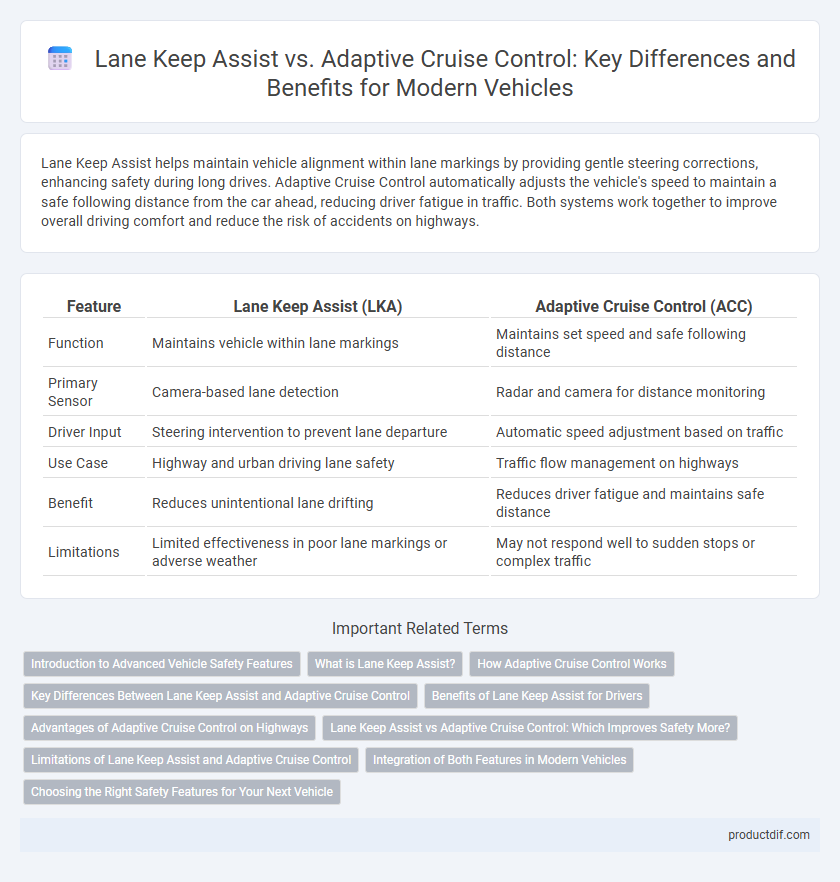Lane Keep Assist helps maintain vehicle alignment within lane markings by providing gentle steering corrections, enhancing safety during long drives. Adaptive Cruise Control automatically adjusts the vehicle's speed to maintain a safe following distance from the car ahead, reducing driver fatigue in traffic. Both systems work together to improve overall driving comfort and reduce the risk of accidents on highways.
Table of Comparison
| Feature | Lane Keep Assist (LKA) | Adaptive Cruise Control (ACC) |
|---|---|---|
| Function | Maintains vehicle within lane markings | Maintains set speed and safe following distance |
| Primary Sensor | Camera-based lane detection | Radar and camera for distance monitoring |
| Driver Input | Steering intervention to prevent lane departure | Automatic speed adjustment based on traffic |
| Use Case | Highway and urban driving lane safety | Traffic flow management on highways |
| Benefit | Reduces unintentional lane drifting | Reduces driver fatigue and maintains safe distance |
| Limitations | Limited effectiveness in poor lane markings or adverse weather | May not respond well to sudden stops or complex traffic |
Introduction to Advanced Vehicle Safety Features
Lane Keep Assist uses cameras and sensors to detect lane markings and gently steer the vehicle to prevent unintentional lane departure, enhancing driver safety. Adaptive Cruise Control adjusts the vehicle's speed automatically by monitoring the distance to the car ahead, maintaining a safe following gap without constant driver input. Both advanced safety technologies significantly reduce the risk of collisions and driver fatigue on highways.
What is Lane Keep Assist?
Lane Keep Assist is an advanced driver-assistance system designed to prevent unintentional lane departures by gently steering the vehicle back into its lane using cameras and sensors. It continuously monitors lane markings and alerts the driver or automatically corrects the steering to enhance safety during highway driving. This technology reduces the risk of accidents caused by drifting and complements Adaptive Cruise Control by maintaining lane discipline.
How Adaptive Cruise Control Works
Adaptive Cruise Control (ACC) uses radar and camera sensors to monitor the distance and speed of the vehicle ahead, automatically adjusting the car's speed to maintain a safe following distance. Unlike Lane Keep Assist, which focuses on steering corrections to keep the vehicle within lane markings, ACC manages acceleration and braking to provide a smoother driving experience in traffic. This system enhances driver convenience and safety by reducing the need for manual speed adjustments on highways and congested roads.
Key Differences Between Lane Keep Assist and Adaptive Cruise Control
Lane Keep Assist primarily focuses on steering by detecting lane markings and helping the driver stay centered within the lane, while Adaptive Cruise Control manages speed and distance by automatically adjusting the vehicle's throttle and brakes to maintain a safe following distance from the car ahead. Lane Keep Assist engages corrective steering inputs when unintentional lane departure is detected, whereas Adaptive Cruise Control actively manages acceleration and deceleration to enhance highway driving comfort. Together, these systems improve safety and convenience but address different aspects of driving control--steering assistance versus speed and spacing regulation.
Benefits of Lane Keep Assist for Drivers
Lane Keep Assist enhances driver safety by preventing unintentional lane departures through gentle steering corrections, reducing the risk of accidents caused by distraction or fatigue. This technology maintains lane discipline, especially on highways, offering greater confidence during long drives and in heavy traffic conditions. By reducing the likelihood of side collisions and improving overall vehicle control, Lane Keep Assist contributes significantly to safer and more comfortable driving experiences.
Advantages of Adaptive Cruise Control on Highways
Adaptive Cruise Control (ACC) enhances highway driving by automatically adjusting vehicle speed to maintain a safe following distance from the car ahead, reducing driver fatigue during long trips. ACC improves traffic flow and safety by reacting to changes in speed without requiring constant driver input, unlike Lane Keep Assist which primarily focuses on steering corrections within lane boundaries. The system's ability to manage acceleration and braking smoothly provides seamless highway cruising and better fuel efficiency.
Lane Keep Assist vs Adaptive Cruise Control: Which Improves Safety More?
Lane Keep Assist continuously monitors lane markings to prevent unintentional drifting, significantly reducing the risk of side collisions and run-off-road accidents. Adaptive Cruise Control maintains a safe following distance by automatically adjusting speed based on traffic flow, decreasing rear-end collision chances during highway driving. Studies indicate that Lane Keep Assist offers greater safety improvements in urban and mixed traffic scenarios, while Adaptive Cruise Control excels on highways, combining both systems provides optimal overall vehicle safety.
Limitations of Lane Keep Assist and Adaptive Cruise Control
Lane Keep Assist struggles with poor lane markings and complex road layouts, leading to inconsistent steering corrections and potential disengagement in heavy rain or fog. Adaptive Cruise Control faces limitations in stop-and-go traffic, often requiring manual override during sudden braking or when detecting stationary objects. Both systems depend heavily on sensor accuracy, which can be compromised by dirt, weather conditions, and sensor malfunctions.
Integration of Both Features in Modern Vehicles
Modern vehicles increasingly integrate Lane Keep Assist and Adaptive Cruise Control to enhance driving safety and convenience by combining steering and speed control functionalities. These advanced driver assistance systems use radar, cameras, and sensors to maintain lane positioning and adjust speed based on traffic flow, reducing driver fatigue on highways. Seamless integration allows for coordinated responses to road conditions, improving overall vehicle autonomy and situational awareness.
Choosing the Right Safety Features for Your Next Vehicle
Lane Keep Assist enhances safety by preventing unintentional lane departures through gentle steering corrections, ideal for drivers seeking extra lane discipline. Adaptive Cruise Control maintains a set speed while automatically adjusting to the traffic flow, reducing driver fatigue during long highway drives. Selecting the right safety feature depends on your driving environment and habits, with Lane Keep Assist suited for urban and tight road scenarios, and Adaptive Cruise Control optimal for highway commuting.
Lane Keep Assist vs Adaptive Cruise Control Infographic

 productdif.com
productdif.com